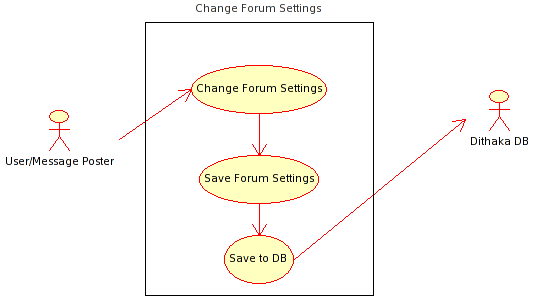Change Forum Settings
The user can edit the default settings of the mail forum. The following settings are available:
- Add footer text allowed: A footer can be added to the outgoing mail messages. A boolean is provided to toggle this feature.
- Footer text: The text to add as footer
- Subject prefix allowed: A subject prefix can be added to all messages from this forum. A boolean is provided to toggle this feature.
- Attachments allowed: This features allows Dithaka to allow or disallow attachments being added to mails. This feature is not implemented as yet.
- List name: This is the forum name.
- Subject Prefix: This is the text to add as a subject prefix. It defaults to the list name.
- Reply-To-List: This feature is used to specify if the reply should be sent to the sender or the list/forum. This feature is currently not implemented but should be implemented in a future release. The default is to reply to the list.
- Members only: When this feature is set to true only members are allowed to post messages to this forum.
- Maximum attachment size: If attachments are allowed we can limit the size of these attachments. This feature is also not implemented as yet.
- Maximum message size: Message are limited in size by this setting. The size can be specified in bytes, in kilo bytes by adding "k" or in mega bytes by adding "m" to the end of the value.
- Sending options for the e-mails being send out to the subscribers of the forum. The mail headers can be controlled to hide the subscriber e-mail addresses and also set the reply to headers of the e-mails. There is currently three solutions.
In all three solutions the Reply-To is set to the list. The solutions are:
- From address is the alias e-mail address and the recipients e-mail addresses are hidden by Bcc them.
- The From address is the alias e-mail address and the e-mail is broken up and sent to each subscriber using the real email address in the To address field.
- The From address is set to the list and the recipients are hidden by Bcc them.
Change Forum Settings Use Case


